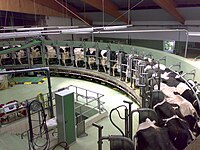
Photo from wikipedia
The aim of this study was to investigate the effects of a concentrate strategy based on the individual cow partial mixed ration (PMR) intake compared with a flat rate. Half… Click to show full abstract
The aim of this study was to investigate the effects of a concentrate strategy based on the individual cow partial mixed ration (PMR) intake compared with a flat rate. Half of the cows were fed the individual concentrate strategy, whereas the other half were fed the control strategy. The individually fed cows were offered a concentrate proportion equal to 30% of the ad libitum intake of the PMR in the automatic milking system, and the control cows were offered 3 kg of concentrate/d in the automatic milking system. The cows (83 Holstein and 64 Jersey), kept in 2 separate groups, were blocked between the treatments according to expected calving date, breed, and parity and were randomly divided between treatments. Lactation was divided into 3 periods (early, mid, and late lactation), and the MIXED and GLIMMIX procedures in SAS (SAS Institute Inc., Cary, NC) were used to analyze the production and behavioral responses. The response trajectories during lactation were analyzed with a MIXED procedure fitted by Wilmink parameters. The individually fed cows had a higher concentrate intake and a lower PMR intake than control cows. Moreover, the total dry matter intake and energy-corrected milk yield did not differ between concentrate strategies. The actual average concentrate intake reached 19% of the PMR intake during mid lactation and not 30% of the PMR intake, as intended with the strategy. This was due to leftovers and lower allocation than intended. The cow behavior did not differ between concentrate strategies. However, variation in PMR intake and eating rate between cows fed individually was lower during mid lactation and lower for lying bouts during early lactation compared with control cows. This may indicate that an individual cow concentrate strategy results in a more stable PMR intake and time budget, which potentially could improve welfare, but this needs further investigation. The overall conclusion is that the cows were robust to adjustments in the concentrate allowance.
Journal Title: Journal of dairy science
Year Published: 2019
Link to full text (if available)
Share on Social Media: Sign Up to like & get
recommendations!